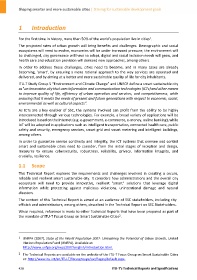Page 438 - Shaping smarter and more sustainable cities - Striving for sustainable development goals
P. 438
1 Introduction
1
For the first time in history, more than 50% of the world's population live in cities .
The projected rates of urban growth will bring benefits and challenges. Demographic and social
ecosystems will need to evolve, economies will be under increased pressure, the environment will
be challenged, city governance will have to adapt, digital and social inclusion needs will grow, and
health care and education provision will demand new approaches, among others.
In order to address these challenges, cities need to become, and in many cases are already
becoming, 'smart', by ensuring a more rational approach to the way services are operated and
delivered, and by aiming at a better and more sustainable quality of life for city inhabitants.
ITU‐T Study Group 5 “Environment and Climate Change” and UNECE define a smart sustainable city
as "an innovative city that uses information and communication technologies (ICTs) and other means
to improve quality of life, efficiency of urban operation and services, and competitiveness, while
ensuring that it meets the needs of present and future generations with respect to economic, social,
environmental as well as cultural aspects”.
As ICTs are a key enabler of SSC, the systems involved can profit from the ability to be highly
interconnected through various technologies. For example, a broad variety of applications will be
introduced based on the Internet (e.g. e‐government, e‐commerce, e‐money, online banking), while
IoT will be adopted in applications such as intelligent transportation, connected health care, public
safety and security, emergency services, smart grid and smart metering and intelligent buildings,
among others.
In order to guarantee service continuity and integrity, the ICT systems that oversee and control
smart and sustainable cities need to consider, from the initial stages of inception and design,
measures to ensure cybersecurity, robustness, reliability, privacy, information integrity, and
crucially, resilience.
1.1 Scope
This Technical Report explores the requirements and challenges involved in creating a secure,
reliable and resilient smart sustainable city. It considers how administrations and the overall city
ecosystem will need to provide innovative, resilient "smart" solutions that leverage digital
information while protecting against malicious violations, unintentional damage and natural
disasters.
The content of this Technical Report is aimed at an audience of SSC stakeholders, including city
officials and administrators, among others, described in the Technical Report on SSC Stakeholders.
When required, reference is made to other Technical Reports that have been prepared as part of
2
the mandate of ITU‐T Focus Group on Smart Sustainable Cities .
1 UNFPA (2007), State of the World Population 2007: Unleashing the Potential of Urban Growth, United
Nations Population Fund (UNFPA). Available at:
http://www.unfpa.org/swp/2007/english/introduction.html.
2 The Technical Reports are available on the website of the ITU‐T Focus Group on Smart Sustainable Cities
at: http://www.itu.int/en/ITU‐T/focusgroups/ssc/Pages/default.aspx.
428 ITU‐T's Technical Reports and Specifications

